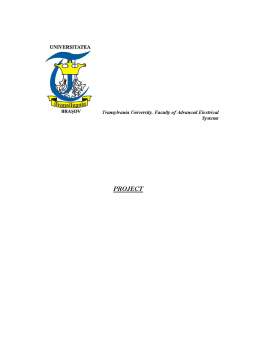Cuprins
- CUPRINS 2
- THEME: 3
- 1.INTRODUCTION 4
- 1.1. BOOST CONVERTER: 5
- 1.2.PMSG-PERMANENT MAGNET SYNCHRONOUS GENERATOR 11
- ADVANTAGES OF PERMANENT MAGNETS IN SYNCHRONOUS GENERATOR 11
- DISADVANTAGES OF PERMANENT MAGNETS IN SYNCHRONOUS GENERATOR 11
- 2. DESIGN AND PARAMETERIZATION OF THE CIRCUIT COMPONENTS 12
- 2.1. DESIGN OF THE L AND C COMPONENT FOR A BOOST CONVERTER WITH THE FOLLOWING SPECIFICATIONS. 12
- 2.2. LOSS CALCULATION FOR MOSFET 16
- 2.3. RCD SNUBBERS 18
- 2.4. SCHOTTKY DIODE (U>100[V] AND I>15[A]) 21
- CONSTRUCTION 21
- REVERSE RECOVERY TIME 21
- LIMITATIONS 22
- SILICON CARBIDE SCHOTTKY DIODE 22
- APPLICATIONS 22
- 3.SIMULATION OF THE WIND TURBINE BATTERY SYSTEM FOR AUTONOMOUS APPLICATION-DESIGN USING MATLAB SIMULINK. 24
- 3.1.MATLAB INTRODUCTION. 24
- 3.2. WIND TURBINE BATTERY SYSTEM SCHEME FOR AUTONOMOUS APPLICATION. 25
- 4. BIBLIOGRAFY. 28
- 5.ANEXE. 29
- ANEXE.1. 29
- ANEXE.2. 30
- ANEXE.3. 32
- ANEXE.5. 37
Extras din proiect
Theme:
,, Modeling and simulation of converting a wind turbine battery system for autonomous application-design. ,,
A controlled wind generation system for a stand alone application is presented in this paper. A cascaded step-up power electronic converter topology is proposed to control the wind power system in the whole wind speed range. For the low wind speed range, the control strategy is aimed to follow the wind turbine’s maximal power coefficient by adjusting the generator’s rotational speed. For high wind speeds, the system power regulation is also made by controlling the generator speed. This control is made by the DC/DC power electronic converter, which modifies its input voltage, changing the machine voltage and consequently varying the generator’s rotor speed. The proposed system is validated by computer simulation. The proposed control system shows a good performance for its application in autonomous wind energy systems
Fig. 1. Wind turbine battery system.
1.Introduction
Isolated places or locations where the grid is unavailable are one of the main commercial applications of stand-alone wind turbines. Autonomous variable speed wind energy systems have been studied in the past decades and they have shown a high efficiency and good performance in face of constant speed or non controlled systems, even in low power range. For wind turbines (WT) of less than 50 kW, particularly in the lowest power range, the permanent magnet synchronous generator (PMSG) is mostly chosen because of its low cost, reduced power losses, simple construction and no external magnetization characteristics.
Most of switch-mode electronic power converters, from small DC/DC choppers to large AC/AC three phase converters, are used to obtain an efficient power transfer from the WT rotor to the electrical system. The system’s power level defines the appropriate power electronic converter: choppers for battery chargers and low power DC applications and voltage or current source inverters for the connection to AC power systems. Electrical machine drives are the optimal complement for classic aerodynamic wind turbine control strategies. The variable speed operation of the electric machine (in indirect grid connection or isolated applications) has shown advantageous for several reasons.
Previously studied power structures and control schemes in low power wind energy systems are helpful to propose a new topology. In this article, a power electronic conversion system with a diode rectifier and a cascaded DC/DC converter is presented and studied for its application in a stand-alone wind energy system. The cascaded DC/DC converter is composed of a boost converter to optimize the wind turbine operation for all its wind speed range. The proposed topology is well suited for a low power DC system with battery storage. Along with the electrical generator, the principal electric component of the proposed wind energy system is the proposed DC/DC converter. Controllability of the system voltage allows the machine rotational speed adjustment to obtain the maximal wind turbine available power. A simple linear control for the system rotation speed gives the voltage reference to a feed-forward control of the cascaded converter. Results show that the proposed structure can operate with a good performance in a stand-alone wind energy conversion system for low power generation applications.
Preview document
Conținut arhivă zip
- Modeling and Simulation of Converting a Wind Turbine Battery System for Autonomous Application-Design.doc











































